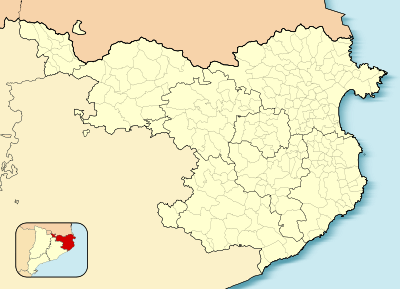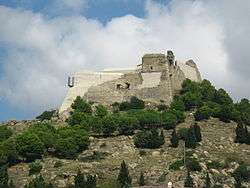Roses, Girona
| Roses | |||
|---|---|---|---|
| Municipality | |||
 | |||
| |||
 Roses  Roses Location in Catalonia | |||
| Coordinates: 42°15′47″N 3°10′59″E / 42.26306°N 3.18306°ECoordinates: 42°15′47″N 3°10′59″E / 42.26306°N 3.18306°E | |||
| Country | Spain | ||
| Community | Catalonia | ||
| Province | Girona | ||
| Comarca | Alt Empordà | ||
| Government | |||
| • Mayor | Montse Mindan Cortada (2015)[1] | ||
| Area[2] | |||
| • Total | 45.9 km2 (17.7 sq mi) | ||
| Elevation | 5 m (16 ft) | ||
| Population (2015)[1] | |||
| • Total | 19,575 | ||
| • Density | 430/km2 (1,100/sq mi) | ||
| Demonym(s) | Rosinques | ||
| Website |
www | ||
Roses (Catalan pronunciation: [ˈrɔzəs], Spanish: Rosas, Spanish pronunciation: [ˈrosas]) is a municipality in the comarca of the Alt Empordà, located on the Costa Brava, in Catalonia, Spain.
It is the site of former bishopric Rotdon, now a Latin Catholic titular see.
It is situated on the coast at the northern end of the Gulf of Roses, and is an important fishing port and tourist centre.[3] The C-260 road links the town with Figueres.
History
Early history

The origins of Roses (Greek: Rhode) are disputed. A popular theory holds it was founded in the 8th century BC by Greek colonists from Rhodes. It seems more probable that it was founded in the 5th century BC by Greeks from Massalia (Marseilles), perhaps with an admixture of colonists from neighbouring Emporion (today's Empúries). Remains of the Greek settlement can still be seen. Remains from the Roman period go back to the 2nd century BC and continue well into Christian times with a paleochristian church and necropolis. After the collapse of Roman power the town seems to have been abandoned, but a fortified settlement from the Visigothic period has been excavated on the nearby Puig Rom.
The mediaeval town grew around the monastery of Santa Maria de Roses (mentioned since 944). Its jurisdiction was shared by the abbots of Santa Maria de Roses and the counts of Empúries. In 1402 the county of Empúries was incorporated into the Crown of Aragon and Roses acquired the right to organize its own municipal government and economy.
Fortification

In the first decades of the 16th century Roses suffered repeated attacks by privateers from North Africa. To counter the threat, Charles V ordered the construction of extensive fortifications in 1543. In spite of the precautions, a naval squadron led by the Turkish admiral Barbarossa attacked and plundered the town some months later. After substantial revisions, the fortifications were completed in 1553, under Charles's son Philip II. The entire medieval town was enclosed by a bastioned pentagonal wall (illustration, below). The defensive system was supplemented by the Castell de la Trinitat, some 2.5 km to the east. The town received a permanent military garrison, which profoundly changed its character. To minimise friction between the citizenry and the soldiers, barracks were constructed, but did not prevent the gradual movement of part of the population to outside the walls, where the modern town of Roses now is.
In the following centuries the fortifications were severely tested. In 1645, during the Catalan Revolt, French troops besieged Roses and captured it. The Treaty of the Pyrenees (1659) restored the town to Spain.
In 1693, during the War of the Grand Alliance the French captured the town again. This time the French occupation lasted until the Peace of Ryswick in 1697. In 1712, during the War of the Spanish Succession, Austrian troops tried to take the city, but were driven off. In 1719, during the War of the Quadruple Alliance, the French again attacked, but failed to take Roses.
After a long period of relative calm the Wars of the French Revolution ushered in a new round of hostilities. In 1793 the French revolutionary government declared war on Spain. At first, the Spanish armies won a foothold in France, but in 1794 the revolutionary armies invaded Catalonia. The Siege of Roses lasted from 28 November 1794 until 3 February 1795, when the garrison was safely evacuated by a Spanish naval squadron, except for 300 soldiers. The town was surrendered to France, but the war between France and Spain ended at the Peace of Basle signed in July 1795. The city quickly returned to Spanish control.
In 1808, Emperor Napoleon I of France forced King Charles IV of Spain and his son Ferdinand to abdicate and installed his brother, Joseph Bonaparte on the throne. When the Spanish people revolted against this high-handed behavior, French armies again invaded the country in the Peninsular War. The fourth and last Siege of Roses occurred in 1808. During the operation, the Scottish Royal Navy captain, Thomas Cochrane assisted the Spanish by putting his men into Castell de la Trinitat to help defend the town. The Scot stayed until the citadel and the town surrendered, before evacuating himself and his men. In 1814, when the defeated French withdrew from Spain, they blew up the town's fortifications along with the Castell de la Trinitat. At this time, the ancient town, called the Ciutadella, was completely ruined. Meanwhile, to the east the modern town slowly continued to grow.
Contemporary age

In 1879 Roses suffered a devastating economic crisis through phylloxera, a pest of the grapevines, that destroyed the town's wine growing industry. Some of the population moved to Barcelona or emigrated to the United States.
In the 20th century, notably in the period after World War II, Roses has profited from the growth of tourism.
Over the last decades important excavations have been carried out inside the walls of the Ciutadella concerning not only the Greek and Roman remains, but part of the medieval city and its walls. In the 1990s extensive restoration work was carried out on the walls of the Ciutadella, and in 2004 a museum was opened inside it. A controversial restoration of the Castell de Trinitat was formally completed in 2010.
Roses was the home of El Bulli, one of the world's best and most famous restaurants, from 1961 until its closure in July 2011. El Bulli had held three Michelin stars since 1997 and was rated the world's best restaurant for four years running since 2005 by Restaurant Magazine.[4][5]
Ecclesiastical history
The monastery of Santa Maria de Roses is mentioned in a document of the year 944. Around the monastery grew the mediaeval town of Roses, whose jurisdiction was shared by the abbots of Santa Maria de Roses and the counts of Empúries.
As Rotdon, it was a suffragan bishopric of the Metropolitan Roman Catholic Archdiocese of Tarragona, but faded.
Titular see
The diocese was nominally restored in 1969 as a Latin Catholic titular bishopric.
It has had the following near-consecutive incumbents, of the fitting episcopal (lowest) rank :
- William Tibertus McCarty, Redemptorists (C.SS.R.) (1969.09.11 – 1971.01.13)
- Francis Lenny (1974.05.03 – 1978.07.16)
- Laurence Forristal (1979.12.03 – 1981.06.30)
- John Anthony Rawsthorne (1981.11.09 – 1997.06.04)
- Néstor Hugo Navarro (1998.04.15 – 2003.03.19)
- Enrique Benavent Vidal (2004.11.08 – 2013.05.17)
- Jesús Fernández González (2013.12.10 – ...), Auxiliary Bishop of Santiago de Compostela (Galicia, Spain)
References
- 1 2 "Ajuntament de Roses". Generalitat of Catalonia. Retrieved 2015-11-13.
- ↑ "El municipi en xifres: Roses". Statistical Institute of Catalonia. Retrieved 2015-11-23.
- ↑ Roses information
- ↑ http://www.theworlds50best.com/page/home.html
- ↑ Zoe Williams (30 July 2011). "El Bulli closes: Farewell parmesan frozen air ... | Life and style". London: The Guardian.
Sources and external links
- Printed sources
- Lluís Buscató i Somoza. La colònia grega de Rhode. Figueres, 1999. ISBN 84-88589-64-6.
- Narciso Díaz i Romañach. Roses: Una vila amb història. Roses, [1991]. ISBN 84-606-0033-5.
- Carlos Díaz, Hug Palou, Anna Ma. Puig. La Ciutadella de Roses. Girona, 1998. ISBN 84-86812-79-8.
- Pablo de la Fuente. Les fortificacions reials del golf de Roses en l'època moderna. Figueres, 1998. ISBN 84-88589-54-9.
- Pere de Palol. El Castrum del Puig de les Muralles de Puig Rom (Roses, Alt Empordà). Girona, 2004. ISBN 84-393-6654-X.
- Marcel Pujol i Hamelink. La vila de Roses (segles XIV-XVI). Figueres, 1997. ISBN 84-88589-42-5.
- External links
| Wikimedia Commons has media related to Roses, Girona. |
- Official website
- Information - Generalitat de Catalunya
- Statistical information - Institut d'Estadística de Catalunya
 |
Palau-saverdera | La Selva de Mar | El Port de la Selva |  |
| Castelló d'Empúries | |
Cadaqués | ||
| ||||
| | ||||
| Mediterranean Sea |

